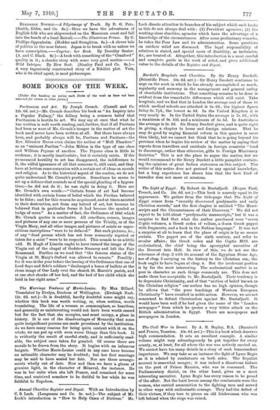SOME BOOKS OF THE WEEK.
[Under this heading us notice such Books of the week al have not been reserved for review in other forms.] Puritanism and Art. By Joseph Crouch. (Cassell and Co. 12s. 6d. net.)—Mr. Crouch describes his book as "An Inquiry into a Popular Fallacy," the fallacy being a common belief that Puritanism is hostile to art. We may say at once that what he has written is well worth reading, and, further, that if all Puritans had been or were of Mr. Crouch's temper in the matter of art the book need never have been written at all. But there have always been, and probably always will be, Puritans and Puritans—the Rev. Silvester Horne even claims the author of "Moll Flanders" as an "eminent Puritan "—John Milton is the type of one class and William Prynne of another. The Prynne class is little in evidence; it is mostly inarticulate ; but it certainly exists. If the pronounced hostility to art has disappeared, the indifference to it the wilful ignorance of all that concerns it, still exist, and they have at bottom some connexion with a certain set of ideas on morals and religion. As to the historical aspect of the matter, we do not quite understand Mr. Crouch's position. Sometimes he seems to set up a defence that reminds us of the special pleading of a bygone time,—he did not do it ; he was right in doing it. Here are Mr. Crouch's own words :—" Certain forms of art had become identified with certain forms of belief which the Puritan believed to be false; and for this reason he acquiesced, and at times assisted in their destruction, not from any hatred of art, but because he believed that in particular forms it had become the symbol or badge of error." As a matter of fact, the Ordinance of 1643 which Mr. Crouch quotes is conclusive. All crucifixes, crosses, images and pictures of any one or more persons of the Trinity, or of the Virgin Mary, and all other images and pictures of saints or super- stitious inscriptions "were to be defaced." But such pictures, &c., of any "dead person which has not been commonly reputed or taken for a saint " were to be respected. This sounds to us a little odd. St. Hugh of Lincoln ought to have turned the image of the Virgin out of the chapel of Godstow Nunnery and left the Fair Rosamund. Further on we read that "the famous statue of the Virgin at St. Mary's Oxford was allowed to remain." Possibly ; for it was in the year before the issuing of the Ordinance that one of Lord Saye and Sele's soldiers "discharged a brace of bullets at the stone image of Our Lady over the church St. Maerie's parish, and at one shot shooke off her hed, and the lied of her child which she held in her right arme."










































 Previous page
Previous page